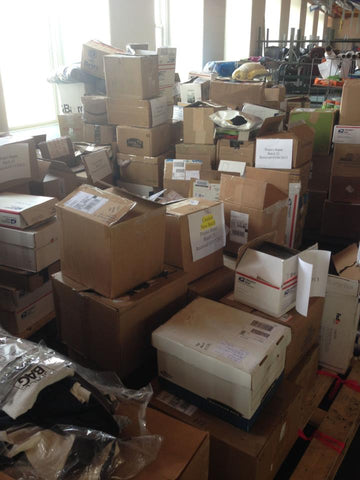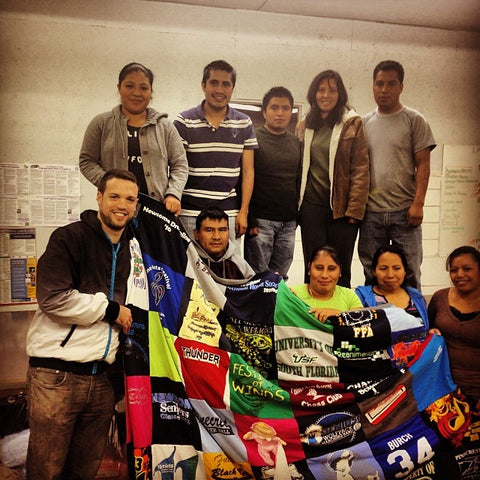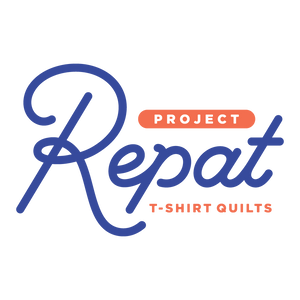What I learned from being on the factory floor
Dec 22, 2013
In anticipation of a big holiday season, we called Molly Hemstreet again, the manager of Opportunity Threads, a worker-owned cut and sew company in Morganton, NC--
"We want to make some of our quilts with you. Would that work?"

(Photo taken March 2012)
Back in March 2012, we had collected hundreds of t-shirts and drove them down to be upcycled into tote bags. We were familiar with the factory, some of the workers, and trusted the quality of their work.
To make the decision, Molly first had to convene with her team, and decide whether to take on this work. When they said yes, we sent some t-shirts down, they made a sample, sent it back, and we agreed to provide about 600 orders from November 1st until December 20th (the last day that USPS guarantees christmas delivery).
The construction of our t shirt quilts is not the difficult part, we explained, it is all the other factors. We have to interpret customers notes, and everyone has a different way of explaining what they want- with notes, or with masking tape marking the sides, or visual maps. For a factory to have to stop and interpret these notes is difficult, what makes it even more difficult is that most of the workers at Opportunity Threads are not native english speakers.
The plan was to start telling customers to send their shirts to Opportunity Threads the second week of November, and then I would show up a week later, and be there to go through the process with them.
It had been awhile since I was involved with the day to day production process. At one point, every order had showed up at our office, we had checked all the notes, checked it into our system, and then once enough orders began to accumulate, we would drive them down to Fall River, MA to get cut and sewn, and then a few weeks later, when they were complete, we would pick them up,and send them out from our Roxbury office.

(Photo taken January 2013)
But since January 2013, a majority of the orders were going straight to production, and then they were being shipped out. This allowed us to focus on selling, and creating more opportunities for us to grow the business. It's a natural progression for a business to contract our production, and focus on its core competency, but you lose touch with the intracacies of the production process, and can't identify problems in the production line.
When I returned to Opportunity Threads last month for the first time since March 2012, it felt great to be back. Like many others before, we had come down with a product that we believed would sell, but had no way of proving that. We were wrong. Customers did not want to pay for our original concept of up cycled tote bags, and we could not provide more work to Opportunity Threads.

(November 2013)
Now we had customers, and every box that came in full of someones t-shirts meant that we already had a customer willing to pay, and once the product was cut and sewn, we could pay Opportunity Threads.
On our first day together again, we immediately began to walk through the process. First step was to open the box, and pick up the notes. It said " Please use all the fronts of the shirts except for the ones I marked. Can you please place the jersey in the middle of the quilt." We checked it into our Klaviyo Assembly line system, and entered it into a spreadsheet so we could monitor the workflow from Boston. We would know the exact date an order arrived, and it would trigger an email to the customer letting them know their order was being processed.
Once we knew the size of the tshirt quilt, we could cut the proper amount of fleece to correspond to the order, and the cutters would begin cutting a foot by a foot out of each shirt. Once all the panels were cut, we could then sort out all the colors, while also following the customers direction. Then, the cut panels would be put back in the bag corresponding with their order number, and taken to the sewing team, where each row is sewn together, and then the fleece is sewn to the back
.
We had never liked being micromanaged, and never felt it was our responsibility to tell the production partner exactly how to make them, since we also had no ability to sew these myself. But in the past, we had just dropped off the shirts, and had a brief conversation with the partner, and expected them to get it right. We were so scarred by creating something that nobody bought, that we overcompensated, and did not spend anytime weeding through the details of our production process. They were the partner with the manufacturing skills, and we just had a basic maxim for them to follow: 'don't hack the shirts, keep them all together corresponding with the customer, and follow the customers directions as close as possible." To make a few of these a day, this is a relatively simple task, but when you start to have to manage hundreds of orders coming in, and thousands of t-shirts, it becomes more complicated.
But with Molly and the Opportunity Threads production team we felt more comfortable giving directions, and they were more receptive to hearing it. They wanted to know how the other production partners did it- there was no need to reinvent the wheel.
After spending a few days, sorting and doing quality control at the end of the line, I returned to Boston confident they would be able to ship a great product, and planned to return during the final week.
On Monday December 16, I returned, and immediately started going through the pile of HOLD orders. These are customers who did not send enough shirts, or had made confusing requests, some t-shirts were in this bag, some were in another, and it was tough to distinguish and interpret the instructions. I started calling customers and trying to get a sense of what they wanted, but it was difficult since they had to remember what shirts they sent, and for those who ordered multiple quilts in one order, it became even more complicated.
I then walked over the cutting table they set up, and could see the difficulties trying to determine best parts of the shirt to cut, or which sides. Sometimes notes fell off, especially with sticky notes, and then there were notes like "Use Both Sides, but Front for the Front and Back for Back." These kind of notes caused huge bottlenecks in the production process. Once all the cutting was done, they had to be 'sorted' so all the colors were not together, and the blanks were spaced out. This required taking out all the cut panels, putting them all on the table, looking at everything we had, and then fitting them together like a puzzle.

(December 2013)
After just a few hours of seeing this process play out, with the crunch of the Christmas guarantee deadline looming, it was easy to see we had a bottleneck problem. As Molly and I checked each quilt that came from production, I started looking at the time studies again, and it was clear to see the problem: we were spending too much time cutting ( reading notes) and sorting the shirts. All the intangibles were taking longer than the actual manufacturing. When a customer sent a photo, and only sent us the sides of the shirts they want used, it actually made the process much easier, thus reducing a lot of time, which ultimately reduces the production cost.
We learned last year to never make assumptions about what customers were willing to pay for, it was important to test it as quick as humanly as possible. In the past year, after making over 13,000 quilts, we were also learning to never make assumptions about how someone wanted their t-shirts cut and sewn, but our production process didn't reflect this. We were actually penalizing customers for being very clear about their instructions. If they sent a photo requesting a specific placement, we charged them more, but it actually made our production process easier.
In the next few weeks, we are going to revamp our process to make it easier for customers to let us know exactly what they want, and make our production process more efficient. This only was able to happen because we had a production partner in Opportunity Threads that was transparent with the time it took to make the quilts and gave us a detailed pricing structure. While we had spent time opening the packages ourselves, without spending full days on the factory floor, we could not make improvements. We look forward to continuing to improve and offering a better way for customers to use our service in 2014.


